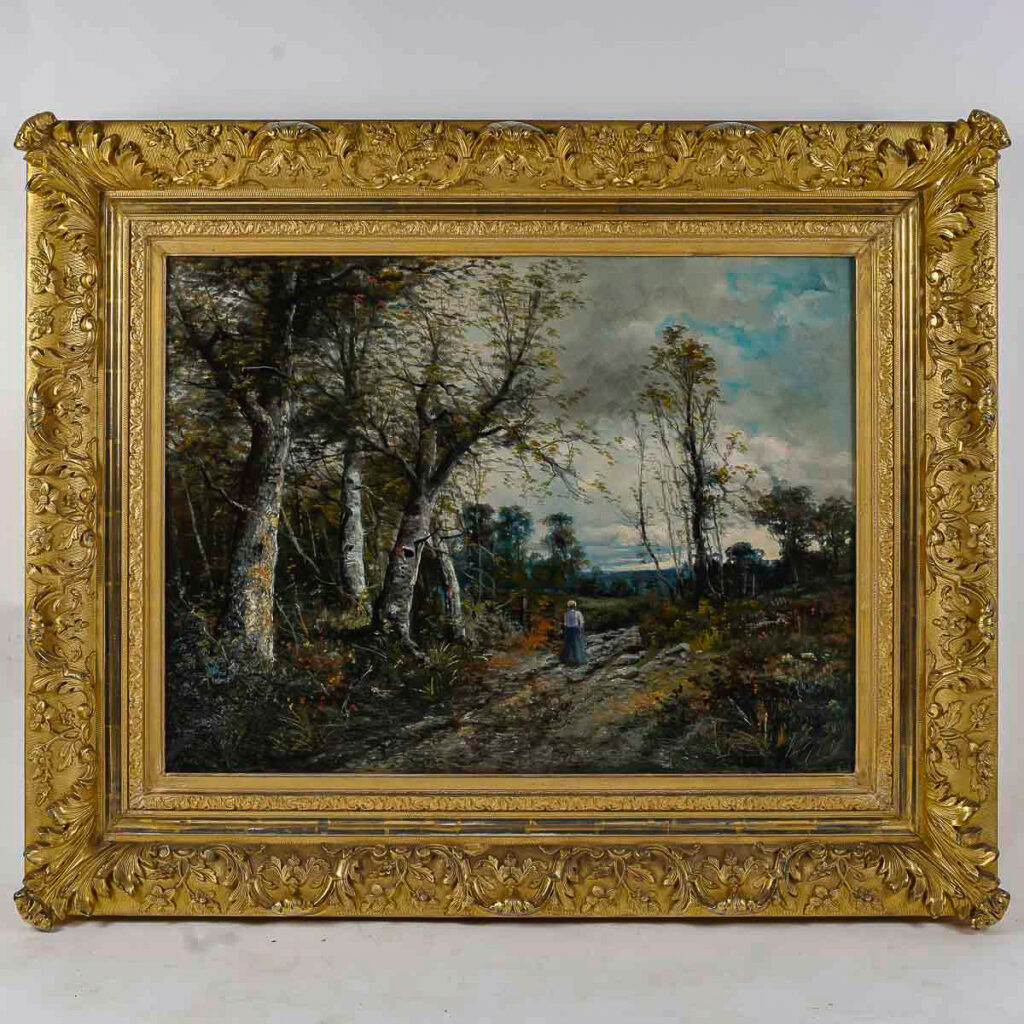Jules Dupré (1811-1889) Promenade en Foret Barbizon School oil on canvas circa 1870
Exhibiting a work by Jules Dupré is always a special occasion. This world-renowned French painter is keepted in the greatest museums, including the Louvre, Orsay, the Frick Collection and the Metropolitan Museum of Arts.
This magnificent painting, by the Barbizon school, is to be compared with the one exhibited at the Musée d'Orsay in the Barbizon room, entitled The Oak, circa 1870.
An oil painting on its original canvas, signed lower left, depicting La promenade in forest.
The eye is immediately focused on the quality and technique used to depict the atmosphere of Autumn, and if we look carefully we can understand what Vincent Van Gogh wrote to his brother about his admiration for Jules Dupré. Our gaze then turns to the bewitching trees. Finally, the light emanating from this canvas draws you into the heart of the scene.
The Beethoven of landscape: The quiet simplicity of Jules Dupré's country paintings conceals a certain lyricism. This is hardly surprising, given that the painter, a passionate music lover, never tired of listening to his mother and his first companion, both musicians, play Mozart or Beethoven. Transposed onto canvas, this musicality is expressed in a symphony of colors orchestrated by light.
Trees or Sovereign Nature: The tree imposes itself as the main motif of the painting, dominating the composition with its unwavering verticality.
Dimensions sans cadre : Hauteur 58 cm – Longueur 79 cm.
Dimensions avec cadre : Hauteur 89 cm – Longueur 108 cm.
Our painting is in good condition, with a small restoration visible through the back of the canvas.
We present it in a hand-carved gilt wood frame of the period, which seems to be its original frame.
Biographies:
Jules Dupré: 1811-1889.
Il He was born in Nantes on April 5th 1811 and died in L'Isle Adam on October 6th 1889.
French landscape painter, pioneer of the French landscape, he left his studio to paint outdoors around Paris from 1830, we can acknowledge him to be one of the pioneers of Impressionism.
To say that Jules Dupré is a painter of nature is a gentle understatement. Under the artist's brush, there is nothing but woods, fields and clearings, peaceful pastures and bodies of water reflecting a versatile sky. Nothing in his work contradicts his penchant for the landscape, from the first ceramic decorations of his youth to the rural views of L'Isle-Adam - a small town on the banks of the Oise where he settled permanently in 1850.
More closely associated with the Barbizon school, he stayed for a long time in the shadow of Théodore Rousseau, with whom he had an exclusive and stormy friendship. However, Jules Dupré remains an unclassifiable artist, who borrows as much from Romanticism as from Naturalism, drawing his primary inspiration from the Dutch masters of the sixteenth and seventeenth centuries and the English painter John Constable.
A realism of the intimate: If he broke with the tradition of classical landscape painting by dedicating himself to outdoor painting from 1830 onwards, he continued to prefer the long days of work in his studio. This singularity differentiates him from the painters of the forest of Fontainebleau, headed by Théodore Rousseau, and leads him to conceive scenes without precise geographical references, whose titles evoke typical landscapes - edge of wood, pond, path, large oaks - and given times - rest after the harvest, sunset.
Most often confined in a sort of solitary meditation, he freely arranged his canvases, sacrificing to his imagination the primary truth of the scenes depicted, especially from the year 1850 on. The result is interiorized landscapes, which bear the mark of their creator, as if he alone was capable of revealing them to life. "Nature is nothing, man is everything", the painter from L'Isle-Adam liked to theorize, reaffirming the intimate presence of the artist at the heart of all creation.
Jules Dupré est souvent présenté comme un des fondateurs de l’École de Barbizon, avec Rousseau, Millet, Daubigny, Corot…
Jules Dupré was congratulated for the quality and expressiveness of his skies by his contemporaries: Eugene Delacroix, Camille Corot, Van Gogh (even though they never met) as evidenced by the writings of the period.
Salons – Expositions :
Jules Dupré expose au Salon dès 1831 avec sept tableaux ; cinq tableaux en 1833 ; quatre tableaux en 1834 et en 1835 ; deux tableaux en 1836. En 1839, il y présente sept toiles, des paysages de l’Indre, de la Corrèze et de Normandie, avant de se désintéresser du Salon pour n’y reparaître qu’en 1852 avec trois tableaux, enfin en 1867 (Exposition Universelle) avec treize tableaux.
Museums:
The exhaustive list of museums that keep works of Jules Dupré in the world would be much too long, we will retain emblematic names:
Le Louvre, Musée d’Orsay, Walters Art Museum de Baltimore, Musée des Beaux Arts de Boston, Art Institute of Chicago, DePaul Universty Museum of Chicago, Cleveland Museum of Art, Detroit Institute of Arts, Bass Museum of Miami Beach, Minneapolis Institute of Art, Brooklyn Museum, Metropolitan Museum of Art, Frick Collection, Memphis Brooks Museum, San Francisco De Young Museum, National Gallery of Art de Washington, Musée National des Beaux Arts de Rio de Janeiro, Ordrupgaard Museum de Copenhague, Statens Museum of Kunst de Copenhague, Musée National d’Art d’Azerbaïdjan à Bakou, National Gallery of Victoria à Melbourne, Musée National des Beaux Arts de Buenos Aires….




